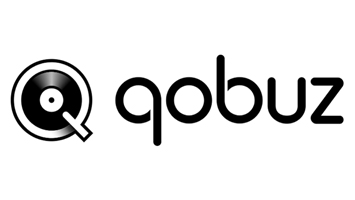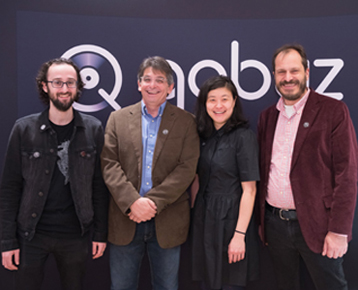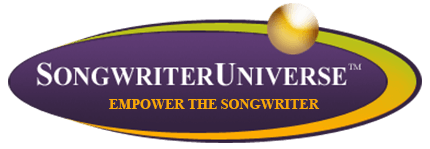Qobuz Emerges With Excellent Hi-Res Streaming Service; Interview with Dan Mackta, Managing Director of Qobuz USA

When it comes to music streaming services, the best-known companies are Spotify, Apple Music, Google Play Music, Amazon Music, Tidal and Pandora. However, a new company has emerged that provides arguably the best sound quality: Qobuz. This company is attracting subscribers by providing high-resolution (hi-res) audio, which is considered to be better than CD quality.
Qobuz is a French-owned company that launched its U.S. service earlier this year (2019). They are focused on presenting music in the hi-res, lossless format: 24 bit/96 kHz or higher, compared to CD quality (16 bit/44.1 kHz). And their hi-res sound is clearly superior to mp3 lossy quality.
Author’s note: I have been an avid fan of Qobuz’s hi-res streaming service since I subscribed to it nine months ago. I had been seeking a streaming service that provides sound quality equal to CD quality, and in some cases Qobuz’s sound quality sounds even better, although the difference between hi-res and CD quality can be slight. It depends on the music speakers or headphones that you’re using to hear music.
Qobuz recently made news, when they announced they were lowering their subscription price. They previously charged $24.99 per month for their hi-res service, which was much higher than the $9.99 fee charged by other companies for mp3 streaming. However, Qobuz is now offering their new Studio Premier (hi-res) streaming for only $14.99 per month (or $12.50 per month if you purchase a one-year subscription for $150). This offer is limited until January 31, 2020, to the first 100,000 subscribers. Here is the link to the Qobuz website: https://www.qobuz.com/us-en/discover
To learn more about Qobuz and its hi-res service, we are pleased to interview Dan Mackta, who is Managing Director of Qobuz’s U.S. operations. Prior to working at Qobuz, Mackta was co-head of marketing for Razor & Tie Recordings in New York. He has also been Vice President of Marketing at both RCA Records and Jive Records/Zomba Label Group.
Here’s our interview with Dan Mackta of Qobuz:
DK: When Qobuz was launched a decade ago, was its goal to always focus on hi-res music?

Dan Mackta: Yes. When it first launched in France, it was a download store only…there was no streaming yet. It was originally launched as a classical only hi-res download store. So audio quality has always been our main thing, although since that time, there have been a number of pivots and evolutions that have gotten us to where we are today.
DK: I believe Qobuz is the first streaming company to provide 24 bits with up to 192 kHz. Can you explain the difference between hi-res, CD quality and mp3 sound quality?
Mackta: In most professional recording studios, the music is recorded at the absolute highest bit depth and bit rate. Recordings are done at 24 bit/96 kHz or 24 bit/192 kHz as a matter of course professionally. So without getting too technical about it, the bit depth—16 bit—which is CD quality, versus 24 bit which is considered hi-res, is the digital word length. It’s basically how much information is in each digital chunk. That’s one variable. And the other is the sampling rate, which is how many times per second the computer takes a digital sample. What gets confusing is when you’re talking about mp3 and similar formats, it’s lossy compression. There’s a lot of mathematics and brain science that goes into the compression schemes that basically take out huge amounts of the information, but are able through scientific leaps, to fool your brain into thinking you’re not really missing the parts that are missing.
So for average, everyday background listening, mp3 and lossy formats are fine. And if you’re talking about the bandwidth—if you want to put the numbers into terms that make it a little easier to understand, mp3 at the top level is 320 kilobits per second mp3…320 K. If you’re looking at CD quality—16 bit audio, expressed in kilobits per second—it’s something more like over 1400 kilobits per second. That’s why you prefer CD over mp3 right there. And then when you get into hi-res, it can be almost 10,000 kilobits per second. So you’re talking about a huge increase in the amount of bandwidth available to convey all of the musical information, without anything needed to be truncated or hidden or otherwise eliminated.
So if you record in 24 bit—24 bit/96 kHz or 24 bit/192 kHz—the dream is that the end user, who’s hearing your music, hears it at the same quality that you recorded in. So from the creative standpoint, that’s the real attraction of lossless and hi-res audio, is that it’s exactly the same. With our service, what goes down at the studio is what goes into our service. What the mastering engineer delivers and what the artist approves, is exactly the same as what the end user hears. There’s no degradation in sound.

DK: Most listeners would agree that there’s a big difference in sound quality, when comparing CDs to mp3s. But do you feel that there’s a clear difference in sound quality between a CD and hi-res?
Mackta: The difference is the most startling between lossy mp3 and CD quality; almost anybody can hear the difference. The difference between CD quality and hi-res is sometimes less startling, especially if your source material is already very compressed, without a lot of dynamic range. You know, all of that extra data that’s available in hi-res, can be understood to be more about the tiny little details. So genres like classical and jazz, that have a lot of dynamics, with a lot of individualized instrumentation and detail to hear, are the most startling when you go to hi-res…you can hear so much.
With some recordings, the beauty of hi-res is not as easy to hear. But in general, I think with hi-res it’s just more headroom, and it can make for a more comfortable, digital listening experience. That’s harder to quantify, but it’s also part of the attraction.
DK: In the coming years, do you think that hi-res will become the standard, and companies like Spotify and Apple will eventually offer hi-res?
Mackta: Well the future is now, because Amazon is already offering it. They just launched Amazon HD—it’s a 24 bit service; they’re the first of the big companies to offer hi-res. And there is demand for it. But I think [hi-res] is going to remain a bit of a specialist item, because many people have never heard uncompressed music. There’s a whole generation of kids who’ve only heard mp3s, so they don’t know that the mp3 is an incomplete representation and it’s not a concern for them. So with hi-res, it’s an education process that we’ve embarked on—stressing the importance of sound quality, educating the listeners, and trying to get more artists on board with the idea of letting their fans know that this is out there. It doesn’t have to be for everybody. But for people like you and me who remember what CDs sound like, or have a hi-fi system at home, or listen to their music on an expensive pair of headphones, those people are already invested in the idea of better sound quality. So we’re offering an option for serious music fans who realize there is something better and want to experience it.
Qobuz is more of a boutique, personalized experience…that’s what Qobuz is all about. We really go out of our way to highlight new albums. When you open up Qobuz, the first thing you see is the new albums. And [you see] music from genres like jazz and classical that are important to audiophiles…that’s where we shine. And then there’s all of the metadata. We display every single credit that is provided by the labels or the artists. We display digital booklets when we get them. We put the music and the creators in the forefront, and offer this more boutique experience for people that are looking for it.
DK: Recently, Qobuz announced a lower-priced Studio Premier plan, which is a hi-res subscription that costs $14.99 per month or $150 per year ($12.50 per month). How long do you plan to offer this deal?
Mackta: This deal was introduced as part of a streamlining of our plans. We used to have three different tiers, including a mp3 tier for $10 per month. We decided that as a strategic move, we were going to one plan, and send the message that everybody should have access to the best possible quality for one price. So we now full access to all of our hi-res and lossless music for one price. We decided [to reduce the price to] $15 per month. We think that it sends a message to the industry and the audience, that [hi-res streaming] is so desirable, that we shouldn’t keep it at a cost that is exponentially higher than other streaming. And we did introduce it as a test, which is why we did it as a limited time offer. We said the first 100,000 subscriptions would receive the Studio Premier plan at this price, but also that we would [end this offer] on January 31. But the testing phase is still happening. So the truth is, we don’t know [whether we’ll end this offer] on February 1. Everybody who was already subscribing, is permanently upgraded to the new plan at the new price. We’d love everyone to give it a try—there’s a one-month free trial.
DK: Currently, other streaming companies like Apple and Spotify offer Family Plans (a discounted price for families to subscribe). Will Qobuz be offering a family plan in the future?
Mackta: Yes, there’s good news on that. In order to do this, we had to negotiate with the record labels, to allow us to offer this pricing, But that’s all been cleared, so we plan to launch [a family plan discount] in the first quarter of 2020. We think that it makes a lot of sense, expecially since we’re trying to get more younger users into lossless and hi-res audio.
DK: In the coming years, 5G technology will be available on phones and other devices. Will the use of 5G make it easier for people to stream hi-res?
Mackta: Everything that I’ve learned about 5G would point to yes. Really, the only reason that we ended up in the situation we’re in now, with everybody walking around streaming compressed, lossy music, is that there was no other way to do it. With 5G coming, my mobile bandwidth is going to become exponentially greater, so one of the primary barriers to enjoying hi-res music on the go, is going to be gone. So I’m looking forward to it, and I think that it’s going to be a game-changer as far as mobile consumption of streaming media, and connectivity in remote areas. I think 5G will make a big difference on a lot of fronts.
DK: You’ve been getting hi-res music from the major labels to stream. But are you getting hi-res music from indie artists?
Mackta: Yes. We have deals with CD Baby and Tunecore, and others like that. We either get the music in hi-res or in CD quality (16 bit lossless). So it’s not hard to get your music on Qobuz.
We’re really focused on the idea of respect for the artist and respect for the listener. That’s why sound quality matters, that’s why the context and credits matter. We welcome everybody to check out Qobuz, and to make sure that their music is on the platform. We work with all of the aggregators and digital distributors as well. There are lots of different ways to get your music onto Qobuz. We want to champion [all kinds of] music.
- Grammy-Winning Artist Charles Kelley (of platinum trio Lady A) Talks About His New Solo Album, Songs For A New Moon - June 26, 2025
- Country Star Brian Kelley Talks About His New Album, Sunshine State of Mind Season Two, Chapter One, And His Songwriting - June 20, 2025
- Betsy Ade & The Well-Known Strangers’ “Standing By” Named June “Best Song Of The Month” - June 9, 2025


